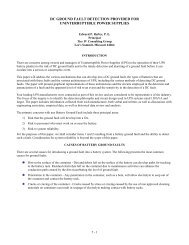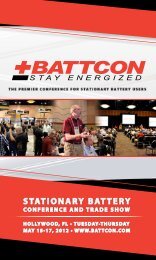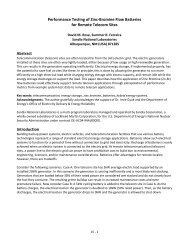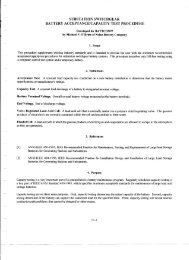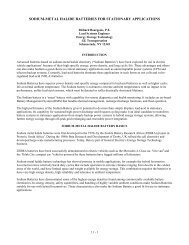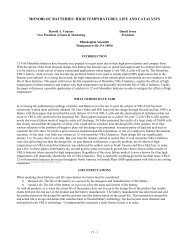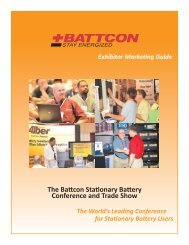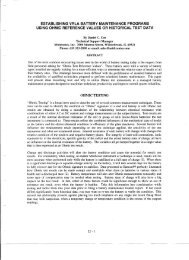HEAT TOLERANT NiMH BATTERIES FOR STATIONARY POWER
HEAT TOLERANT NiMH BATTERIES FOR STATIONARY POWER
HEAT TOLERANT NiMH BATTERIES FOR STATIONARY POWER
Create successful ePaper yourself
Turn your PDF publications into a flip-book with our unique Google optimized e-Paper software.
TECHNOLOGY<br />
A basic <strong>NiMH</strong> cell consists of a metal hydride (MH) anode and a nickel hydroxide cathode in a high conductivity aqueous<br />
potassium hydroxide electrolyte. This chemistry provides a cell potential of 1.2V with an overall discharge reaction which<br />
can be written:<br />
MH + NiOOH M + Ni(OH)2<br />
Where nickel oxyhydroxide is reduced to nickel hydroxide and metal hydride (MH) is oxidized to a metal alloy (M). This<br />
process is reversed during charging. The electrolyte is not consumed in the overall chemical reaction thereby maintaining a<br />
consistent concentration to provide high power and long cycle life.<br />
Adjusting the negative to positive (N/P) ratio to provide excess MH negative electrode capacity enhances the cell’s gas<br />
recombination mechanism to prevent build-up of gasses during overcharge (oxygen recombination) or over-discharge<br />
(hydrogen recombination) situations. This additional capacity also helps to inhibit oxidation or corrosion of the MH alloy.<br />
Cell construction<br />
<strong>NiMH</strong> batteries are constructed in a variety of shapes and sizes, from small<br />
button cells to standard cylindrical sizes to large format prismatic cells up to<br />
250 Ah capacity. Whereas smaller cells routinely use the cell case as an<br />
electrical contact, prismatic cells like that shown in figure 1 utilize individual<br />
terminals which are electrically insulated from the welded lid/case assembly.<br />
The lid also features a re-sealable safety vent.<br />
Technology improvements<br />
Since its market introduction, <strong>NiMH</strong> technology has undergone continuous<br />
improvement and further development, typically following paths specific to<br />
different application requirements such as high power, high energy density,<br />
high cycle life, and other characteristics.<br />
Early consumer <strong>NiMH</strong> AA cells demonstrated a specific energy of 54<br />
Wh/kg. Improvements in electrode materials and manufacturing methods<br />
have more than doubled this value as shown in Figure 2.<br />
Figure 1: Prismatic <strong>NiMH</strong><br />
cell construction<br />
Figure 2: <strong>NiMH</strong> AA cell evolution<br />
Specific energy is reduced somewhat in batteries with enhanced current collectors and other features designed for high power<br />
applications. 45-60 Wh/kg specific energy is normal for hybrid vehicle batteries whose specific power can exceed 1300 W/kg<br />
under both charge and discharge conditions. Traditionally, <strong>NiMH</strong> was considered a low power technology, but some<br />
12 - 2



